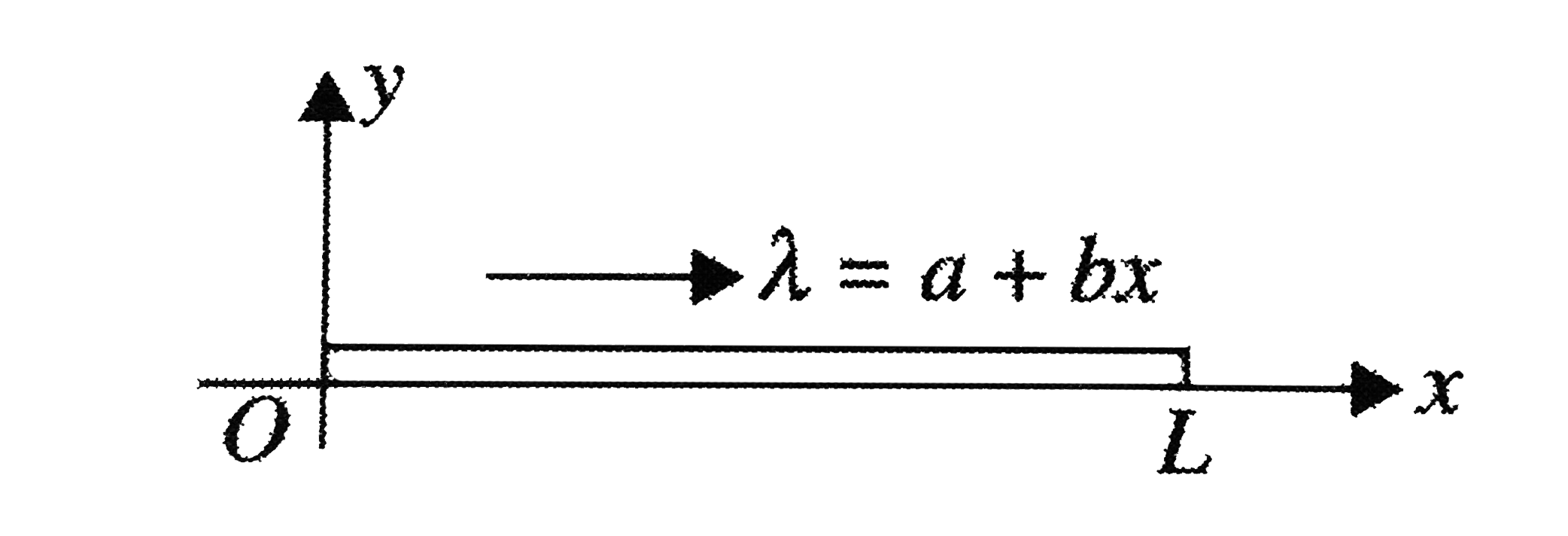A uniform thin rod AB of length L has linear mass density μ(x)=a+bxL, where x is measured from A. If the CM of the rod lies at a distance of (712L) from A, then a and b are related as :_
2a=b
3a=2b
a=2b
a=b
The correct Answer is:A
To solve the problem, we need to find the relationship between the constants a and b given the linear mass density of the rod and the position of the center of mass (CM).
1. Understanding the Linear Mass Density:
The linear mass density of the rod is given by:
μ(x)=a+bxL
where x is the distance from point A along the rod.
2. Setting Up the Center of Mass Formula:
The center of mass xcm for a continuous mass distribution is given by:
xcm=∫L0xdm∫L0dm
Here, dm=μ(x)dx.
3. Calculating dm:
Substituting the expression for μ(x):
dm=(a+bxL)dx
4. Calculating the Numerator:
We need to compute the integral for the numerator:
∫L0xdm=∫L0x(a+bxL)dx
This expands to:
∫L0(ax+bx2L)dx
We can split this into two integrals:
=a∫L0xdx+bL∫L0x2dx
5. Evaluating the Integrals:
- The integral ∫L0xdx=L22
- The integral ∫L0x2dx=L33
Substituting these results:
=a⋅L22+bL⋅L33=aL22+bL23
6. Calculating the Denominator:
Now, we compute the denominator:
∫L0dm=∫L0(a+bxL)dx=aL+bL⋅L22=aL+bL2
7. Putting It All Together:
Now substituting the numerator and denominator into the center of mass formula:
xcm=aL22+bL23aL+bL2
Simplifying this gives:
xcm=L2(a2+b3)L(a+b2)=L(a2+b3)a+b2
8. Setting the Center of Mass:
We know from the problem statement that:
xcm=7L12
Thus, we set the two expressions equal:
L(a2+b3)a+b2=7L12
9. Cross Multiplying:
Removing L from both sides (assuming L≠0):
12(a2+b3)=7(a+b2)
10. Expanding and Simplifying:
Expanding both sides:
6a+4b=7a+7b2
Rearranging gives:
6a+4b−7a−7b2=0
Combining like terms leads to:
−a+(4−72)b=0⟹−a−3b2=0⟹2a=3b
11. Final Relationship:
Thus, we find the relationship between a and b:
2a=3borb=23a
The linear mass density of the rod is given by:
μ(x)=a+bxL
where x is the distance from point A along the rod.
The center of mass xcm for a continuous mass distribution is given by:
xcm=∫L0xdm∫L0dm
Here, dm=μ(x)dx.
Substituting the expression for μ(x):
dm=(a+bxL)dx
We need to compute the integral for the numerator:
∫L0xdm=∫L0x(a+bxL)dx
This expands to:
∫L0(ax+bx2L)dx
We can split this into two integrals:
=a∫L0xdx+bL∫L0x2dx
- The integral ∫L0xdx=L22
- The integral ∫L0x2dx=L33
=a⋅L22+bL⋅L33=aL22+bL23
Now, we compute the denominator:
∫L0dm=∫L0(a+bxL)dx=aL+bL⋅L22=aL+bL2
Now substituting the numerator and denominator into the center of mass formula:
xcm=aL22+bL23aL+bL2
Simplifying this gives:
xcm=L2(a2+b3)L(a+b2)=L(a2+b3)a+b2
We know from the problem statement that:
xcm=7L12
Thus, we set the two expressions equal:
L(a2+b3)a+b2=7L12
Removing L from both sides (assuming L≠0):
12(a2+b3)=7(a+b2)
Expanding both sides:
6a+4b=7a+7b2
Rearranging gives:
6a+4b−7a−7b2=0
Combining like terms leads to:
−a+(4−72)b=0⟹−a−3b2=0⟹2a=3b
Thus, we find the relationship between a and b:
2a=3borb=23a
Topper's Solved these Questions
- CENTRE OF MASSBook:ALLENChapter:CENTRE OF MASSExercise:EXERCISE-V B
Explore 19 Videos
- CENTRE OF MASSBook:ALLENChapter:CENTRE OF MASSExercise:EXERCISE-IV B
Explore 14 Videos
- BASIC MATHEMATICS USED IN PHYSICS &VECTORS Book:ALLENChapter:BASIC MATHEMATICS USED IN PHYSICS &VECTORS Exercise:EXERCISE-IV ASSERTION & REASON
Explore 11 Videos
- ELASTICITY, SURFACE TENSION AND FLUID MECHANICSBook:ALLENChapter:ELASTICITY, SURFACE TENSION AND FLUID MECHANICSExercise:Exercise 5 B (Integer Type Questions)
Explore 3 Videos
Similar Questions
A thin rod AB of length a has variable mass per unit length ρ0(1+xa) where x is the distance measured from A and ρ0 is a constant.
Find the mass M of the rod.
View SolutionThe linear mass density of a thin rod AB of length L varies from A to B as λ(x)=λ0(1+xL). Where x is the distance from A. If M is the mass of the rod then its moment of inertia about an axis passing through A and perpendicualr to the rod is :
View Solution
Knowledge Check
Find centre of mass of given rod of linear mass density λ=(a+b(xl)2) , x is distance from one of its end. Length of the rod is l.
A3l4(3a+b2a+b)B3l4(2a+b3a+b)Cl4(2a+b3a+b)Dl(2a+b3a+b)A rod length L and mass M is placed along the x-axis with one end at the origin, as shown in the figure above. The rod has linear mass density λ=2ML2x, where x is the distance from the origin. Which of the following gives the x-coordinate of the rod's center of mass?
 A23LB14LC13LD12L
A23LB14LC13LD12LThe mass per unit length of a non - uniform rod of length L is given μ=λx2 , where λ is a constant and x is distance from one end of the rod. The distance of the center of mas of rod from this end is
AL2BL4C3L4DL3
A thin rod AB of length a has variable mass per unit length P0(1+xa) where x is the distance measured from A and ρ0 is a constant.
Find the position of centre of mass of the rod.
View SolutionA thin rod AB of length a has variable mass per unit length ρ0(1+xa) where x is the distance measured from A and ρ0 is a constant.
Find moment of inertia of the rod about an axis passing through A and perpendicular to AB.
View SolutionThe mass per unit length of a non- uniform rod OP of length L varies as m=k(x)/(L) where k is a constant and x is the distance of any point on the rod from end 0 .The distance of the centre of mass of the rod from end 0 is
View SolutionYou are given a rod of length L. The linear mass density is λ such that λ=a+bx. Here a and b are constants and the mass of the rod increases as x decreases. Find the mass of the rod

View SolutionThe mass per unit length of a non-uniform rod of length L is given by μ=λ×2, where λ is a constant and x is distance from one end of the rod. The distance of the center of mass of rod from this end is :-
View Solution